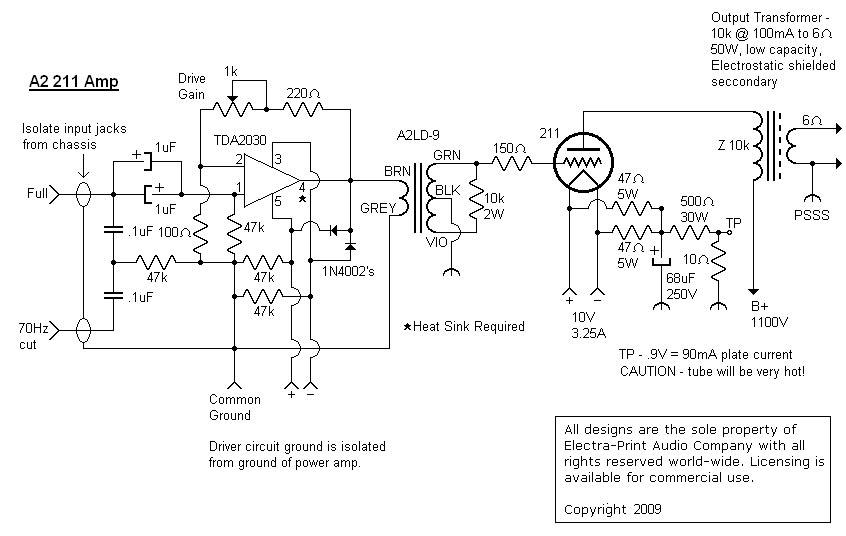Operating classifications of popular amps
Class A
In Class A, the power tube pushes the same amount of current all the time - whether it's idle or at full power. Class A is quite inefficient - electrically; yet - when Class A amps are designed correctly, they produce little distortion.
In Class A1, the grid (g1 in tetrodes and pentodes) voltage is always more negative than the cathode voltage, giving the amp the greatest possible linearity. A1 amps can be constructed with triodes (such as the 2A3, 300b, 845, 211, etc.) as well as with tetrodes and pentodes (such as the 807, KT66, EL34, KT88, etc.).
- Class A1
- the grid voltage is more negative than the cathode voltage
In Class A2, the grid is driven more positive than the cathode for much (or all of the waveform). The grid draws current from the cathode, heating up. Not too long ago, A2 was "frowned on" for use in Hi-Fi amps. Yet - if drive circuitry (capable of supplying a sufficient, clean and constant voltage swing) is implemented, A2 provides a means of squeezing out the maximum amount of Class A watts from a power tube - at a level of distortion acceptable to most people's ears.
- Class A2
- the grid voltage is more positive than the cathode voltage
Below from Electra-print is a prime example of circuitry, capable of driving a lethargic triode into A2 with low distortion. The drive circuit consists of a "chip amp" and an interstage transformer. Chip amps, such as the TDA2030, can push-out about 10 watts of clean power, and the transformer serves to load the grid of the 211 at a constant, low DC resistance - while isolating it from the ambient noise, generated by the TDA2030.

For a large view, here is the full-sized schematic.
Amps which run in Class A1 and A2 are single ended (SE), i.e. they have one or more than one output tube, connected in parallel with the output transformer. Here is a PDF link to some rather esoteric SE amps, running a "zero bias" on the output tubes.
- Single Ended
- one or more tubes in parallel with the output transformer
Class AB
Class AB refers to push-pull (PP) amplifiers - those which have two tubes in series with the output transformer. When one tube's grid is driven until its plate current cuts off, the other tube takes over and handles the power output. AB is more efficient than Class A, but it produces more distortion - due to the tubes, switching on and off. To tame this distortion, most AB amps require negative feedback. As above - and identically to A1 and A2, there are Class AB1 and Class AB2 amps. In AB1, the grid is driven less positive than the cathode. In AB2, the grid is driven more positive than the cathode.
- Push Pull
- two or more tubes in series with the output transformer
In many AB1 amps, a sizeable portion of the waveform is produced in pure Class A. For example, a 30Watt PP amp, can generate Class A watts for 12 watts or so before shifting into AB1. This aspect of PP amps is a significant fact for both amp builders and consumers to consider. Since the average listening level is within a 10-15 Watt range; therefore, no one has to build or shell out a fortune for a high-powered and expensive amp - in order to own an adequately powerful, pleasant-sounding amp.
There are - also - PP amps designed to run solely in pure Class A, but they come with the sacrifice of output power - relative to AB amps. The OddWatt amp is a modern incarnation of such a Class A PP amp.
Regarding the output power of pentodes, tetrodes and these two types of tubes strapped as triodes: a PP Class AB1 amp's power output is roughly 4 times greater than one tube in SE Class A pentode mode and 8 times greater than one tube in SE Class A triode mode.
Here's a terse introduction to tube amp design. The author susses-out input stages, power modes that run tubes in, distortion characteristics, etc.


